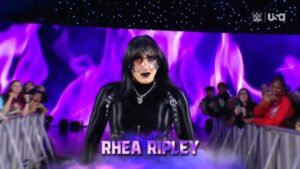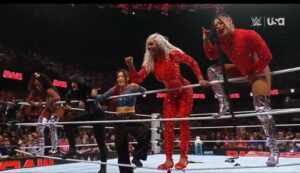With the pomp and circumstance of World Wrestling Entertainment’s (WWE) Wrestlemania, and the litany of shows which took place during the now dubbed Wrestlemania Week in New Orleans, Louisiana, the fallout from New Japan Pro Wrestling’s (NJPW) Sakura Genesis hasn’t received proper coverage.

Coverage of Sakura Genesis found the pages of outlets and airwaves of podcasts which commonly cover NJPW, however the conversation around an altercation on social media was short lived due the media attention Wrestlemania receives.
Nobody knows how to "work" anymore. They would rather kill each other to get @davemeltzerWON to put their match over. That is a problem that needs to be put front and center. Guys are going to keep getting hurt. https://t.co/NTwFopHlDR
— Glenn Gilbertti (@TheRealDisco) April 1, 2018
Stop. You know nothing. You have drawn 0 dollars. No fan has ever left a show thinking about you. You were lucky to be a juiced up double-lifer "over with the boys" type in an era where you hid in plain sight coasting on others' success. Couldn't hang then, can't get booked now. https://t.co/0kiDAgyhlT
— Cody Rhodes (@CodyRhodes) April 2, 2018
Glen Gilbertti, better known by the Disco Inferno moniker, was a two-time World Championship Wrestling (WCW) Television Champion, one-time Cruiserweight Champion, and one-time World Tag Team Champion in the 1990s. While a solid hand who filled the mid-card scene during his tenure in the company, he was never thought as someone who drew fans into a building or pushed merchandise. Since entering the podcast world he has drawn criticism for his tweets encouraging male fans to send him pictures of female wrestling fans, without asking for the consent.

However, his comment in this instance created a stir of criticism, lobbied toward Kenny Omega, Cody Rhodes, and Will Ospreay based on events at Sakura Genesis. Ospreay did have a scary incident where he landed on his head, causing blood to gush from the wound during his IWGP Junior Heavyweight Championship defense against Marty Scurll. Luckily, he didn’t need to spend time at the hospital after the incident.
Back at my hotel now. Time can only tell. Thanks for the messages, can’t help but tell you how much I love you guys.
P.S I could really do without the whole “I told you so” or “This is why” 😂 pic.twitter.com/kAPqmJCFFR
— Will Ospreay • ウィル・オスプレイ (@WillOspreay) April 1, 2018
Without going into specific names, numerous individuals associated with the wrestling business began critiquing Cody, Kenny, and Ospreay for not knowing how to ‘work’ properly nor tell a story without taking ‘unnecessary risks.’ During several conversations, these individuals would admit they actually did not watch the entirety of Sakura Genesis nor do they watch any NJPW programming. This development probably is frustrating to regular NJPW consumers, especially when they hear false claims being made about the product. There will always be individuals like Disco Inferno, Jim Cornette, and others who take shots at the modern product. However, when individuals state that NJPW doesn’t care about telling in-ring stories, they are accidentally admitting their ignorance to the product.

It was only on January 27th at The New Beginning in Sapporo where Hiroshi Tanahashi and Minoru Suzuki told a brilliant story by utilizing a figure four and heel hook for over ten minutes of the match. On March 25th at Strong Style Evolved, The Young Bucks and Golden Lovers told an amazing story during their match. Despite the emotion and passion displayed during the encounter, it didn’t receive attention from the same individuals who often critique NJPW.

Even the main event of Sakura Genesis on April 1st hasn’t been mentioned by these convenient critics. Zack Sabre Jr. was turned into a legitimate main event threat due to his monstrous New Japan Cup run. In two weeks it became believable that he could be the one to end the historic IWGP Heavyweight Championship run of Kazuchika Okada. Their match told a story that isn’t often seen elsewhere in the world.
It may be unfair to say those who critique NJPW without viewing the product are looking for a job elsewhere (especially if they are a fan), but it is worth examining closer – especially as the promotion continues growing exponentially across the international landscape.

Since their founding in January 1972 (the first card was in March of that year), NJPW has been best when they relied on their in-ring product to captivate their audience. Individuals like Antonio Inoki, Billy Robinson, Seiji Sakaguchi, Tatsumi Fujinami, Karl Gotch, Shinya Hashimoto, Great Muta, Nobuhiko Takada, Jushin Liger, Yuji Nagata, Hiroshi Tanahashi, and many others relied on their ability to tell stories within the ring to help the company grow at various points. In actuality, there aren’t many workers employed with the company who take the extreme high flying risks. Yes, you will find the various ‘head drop’ spots, but in the majority of cases, those are performed safely.
The criticism of the NJPW product also raises eyebrows when looking at the numerous injuries which happen in the WWE, in what is lauded by many as a ‘safer’ and ‘smarter’ style. Whatever is the origin of the false criticism directed towards NJPW, the truth exists within the history of the company and their rising popularity among a growing and thankful fanbase.






